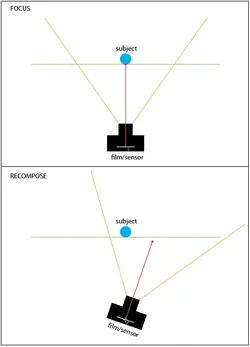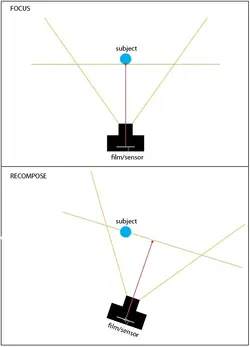since no one seems to read links:
Here's what I posted several years ago:
Here's the calculations from the same thread:
=======
I'm no math wiz.. but.. something to consider.
Assumptions:
* 35mm frame
* recompose to 1/2 the Field of view at a specified focal length
* 10 meter subject distance
* Focal length of 24mm
* Aperture of f/1.4
Fov = 2*arctan(d/2*f)
Fov = Field of view
d = diagonal dimension (35mm for full frame)
f = focal length.
Let's just start at a 24mm focal length
Fov = 2 arctan(35/2*24)
Fov = 72.2 degrees @ 24mm. As per assumption, Frecompose = 72.2/2 = 36.1 degrees
Next... Focus plane error when camera is rotated during recomposition (Frecompose).
E = a - a * COS (t)
E = focus error (behind subject)
a = distance to subject
t = degrees rotation.
Let's just take a subject distance of 10 meters with a rotation of 36.1 degrees
E = 10 - 10 * COS(36.1)
E = 1.9 meters
Now let's lookup the DOF for the same parameters (I use dofmaster.com online calculator)
DOF in front of subject = 4.2 meters
DOF behind subject = 27.7 meters
If my calculations are correct, 1.9 meter focus error should still be within DOF for a 24mm focal length at f/1.4 at a subject distance of 10meters.
I ran through the calculations for 50mm at f/1.4 as well (same 10meter subject distance)
E = 0.15 meters
DOF in front of subject = 1.44 meters
yup still ok...
How about a super fast telephoto 200 f/1.4
E = 0.038 meters
DOF in front of subject = 0.1meters
yup still ok...
Ok ... so 10 meters might be too far.. Lets try a subject distance of 5 meters
24mm Error = 0.95 meters
DOF in front of subject = 1.34 meters.
50mm Error = 0.28 meters
DOF in front of subject = 0.39 meters
200mm Error = 0.019 meters
DOF in front of subject = 0.03 meters.
The way I see it, your are fine until you enter in to the subject distance of 3meters or less. Of course doing this on paper is different than real world use since there are so many other factors involved (CoC for different formats for example).
These are just numbers... whether or not it matters enough to worry about is a personal decision. (I'll keep mine to myself)
Then again.. I suck at math.. so if I made a mistake please point it out.
=========
IMO, making a big deal out of something pretty small..... don't trust everything you read online... think things through.






![[No title]](/data/xfmg/thumbnail/32/32710-b10dfc8ee698235cdc1e7572139173e8.jpg?1734162313)
![[No title]](/data/xfmg/thumbnail/38/38262-10a9668da9a2b36a92cddde57caf87bc.jpg?1734172150)





![[No title]](/data/xfmg/thumbnail/37/37604-7ad625e983f92f880eb65a264eeef5e4.jpg?1734170732)



